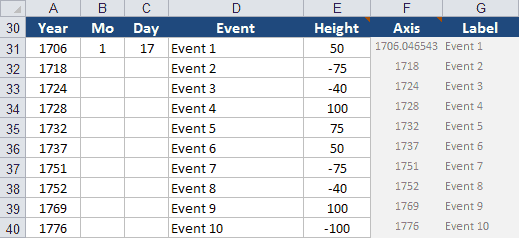Calendar Converter Bc To Ad Years
Astronomical Year Numbering and the Common Era Calendar Astronomical Year Numbering and the Common Era Calendar In years prior to the year 1 are numbered by counting backwards from that year and adding a suffix to distinguish years prior to the year 1 from years following the year 1, e.g., 1 B.C., 2 B.C., and so on. This method of numbering years, although still in widespread use, makes it difficult to perform simple arithmetic operations on years. (E.g., how many years elapsed from January 1st, 6 B.C., to January 1st, 6 A.D.? 13?) Thus many astronomers and calendrical scientists prefer to use a system of numbering years prior to the year 1 using zero and negative numbers. -2, -1, 0, 1,.

Railsback' s ry Ra i l sb ack's ry t AD, CE ”) Calendar years: n 1 BC AD 1. Jewish / Civil Date Converter. BC AD This calendar is the predecessor of the. The terms anno Domini (AD) and. Astronomical year numbering and the ISO 8601 standard designate years so that AD 1 = year 1, 1 BC = year 0. Calendar Converter.

Hence we have the following correspondences: Traditional Christian (English) Traditional Christian (German) 'Religiously neutral' 'Politically correct' Astronomical system 4 B.C. 4 BCE -3 CE 3 B.C.
3 BCE -2 CE 2 B.C. 2 BCE -1 CE 1 B.C. 1 BCE 0 CE 1 A.D. 1 CE 1 CE 2 A.D.
2 CE 2 CE 'CE' is an abbreviation for 'Common Era'. The suffixes 'CE' and 'BCE' ('Before Common Era') in the 'religiously neutral' system simply replace the traditional Christian suffixes 'A.D.' ('Anno Domini'), 'n.Chr.' ('nach Christus'), 'B.C.' ('Before Christ') and 'v.Chr.' ('vor Christus'), so the 'religiously neutral' system of year numbering is no different — except for the cosmetic suffix changes — from the proleptic Gregorian Calendar (the Gregorian Calendar projected back prior to its start on October 15, 1582). A calendar using the astronomical system numbers years in a fundamentally different way from the traditional Gregorian Calendar.
Dates with years so numbered should have a suffix to distinguish them from dates with years numbered in some other way. In practice, however, 'CE' is used both (a) for years from the year 1 onwards in the proleptic Gregorian Calendar in its 'religiously neutral' form and (b) for all years (both positive and negative) in the proleptic Gregorian Calendar in the form which uses the astronomical system of year numbering. The astronomical year numbering system may also be used with calendars other than the proleptic Gregorian Calendar, provided some suffix is used to identify the calendar. Thus, e.g., we have '0 JC' for the year in the Julian Calendar (with astronomical year numbering) which preceded the year '1 JC'.
For years prior to the year 1 in the traditional Gregorian and Julian Calendars the following conversion formulas may be used: n B.C. = -( n-1) CE - n CE = n+1 B.C.
• To convert a year B.C. To CE subtract 1 and prepend a minus sign (e. Cod2 Hack Aimbot Free Download. g., 201 B.C. • To convert a negative year CE to B.C. Drop the minus sign and add 1 (e.g., -533 CE = 534 B.C.). The astronomical year numbering system is used in all dates (both as input and as displayed) in all Hermetic Systems calendrical software (though the program handles dates with both systems of year numbering). The term 'Common Era Calendar' is used in all articles on this website, and in all calendrical software user manuals, to mean that calendar which has the same structure (days, months, years) as the proleptic Gregorian Calendar and in which years are numbered according to the astronomical system. Dates in this calendar are always designated 'CE'.
Comparison with Date Convention Used by Fred Espenak In his web pages giving lunar eclipse dates Fred Espenak uses (as does this website) the astronomical year numbering system, as explained above. However, for any particular eclipse date, he does not state whether this is a date in the Julian Calendar or in the Gregorian Calendar. In fact he is using Julian Calendar dates for eclipses before the official introduction of the Gregorian Calendar in October 1582 (see ) and Gregorian Calendar dates after October 1582. At Espenak has two lunar eclipses dates, '1582 Jul 05' followed immediately by '1582 Dec 09'. The first date (as are earlier dates) is a date in the Julian Calendar, the second date (and later dates) is a date in the Gregorian. Since the page is entitled 'Eclipses 1501 CE to 1600 CE' it might be thought that Espenak is using 'CE' to designate the 'Common Era' a.k.a. 'Gregorian' Calendar, and that his dates prior to October 1582 are in the, whereas they are actually in the Julian Calendar.